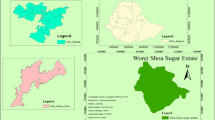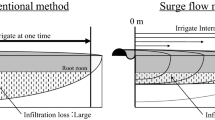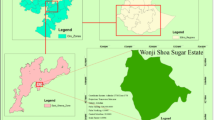Abstract
Meandering furrow irrigation (Gholam-gardeshi irrigation) is a modified form of furrow irrigation, which has being used in Iran, but to date, there is no study about the erosion of this method of irrigation. To measure the erosion of meandering furrow irrigation and to compare the results with standard furrow irrigation, two experimental fields with different soil textures and furrow inflow rates were used. The experiment utilized a randomized factorial design with three replications for each treatment. In both methods, the developed second order polynomial equation for the erosion, and advance equation were able to predict the field data with coefficients of determination of more than 0.94. The results showed that the velocity of advance, tail water runoff and erosion are significantly lower for meandering furrow irrigation as compared to standard furrow irrigation. As the furrow inflow rates increased, erosion and runoff in both irrigation methods increased significantly.







Similar content being viewed by others
References
Aarstad JS, Miller DE (1978) Corn residue management to reduce erosion in irrigation furrows. J Soil Water Conserv 33:289–291
Carter DL (1993) Furrow irrigation erosion lowers soil productivity. J Irrig Drain ASCE 119(6):964–974
Evans RG, Girgin BN, Chenoweth JF, Kroeger MW (1995) Surge irrigation with residues to reduce soil erosion. Agric Water Manage 27(3–4):283–297
Gaton JE (1966) Designing an automatic cut-back furrow irrigation system. Oklahoma Agric Exp Sta Bull B- 651
Goodson CC, Schwartz G, Amrhein C (2006) Controlling tailwater sediment and phosphorus concentrations with polyacrylamide in the Imperial Valley. Calif J Environ Qual 35:1072–1077
Koluvek PK, Kenneth KT, Trout TJ (1993) Overview of soil erosion from irrigation. J Irrig Drain ASCE 119(6):929–946
Leib BG, Redulla CA, Stevens RG, Matthews GR, Strausz DA (2005) Erosion control practices integrated with polyacrylamide to reduce sediment loss in furrow irrigation. Appl Eng Agr 21:95–603
Mintesinot B, Verplancke H, Van Ranst E, Mitiku H (2004) Examining traditional irrigation methods, irrigation scheduling and alternate furrows irrigation on vertisols in northern Ethiopia. Agric Water Manage 64(1):17–27
Mostafazadeh-Fard B, Moravejalahkami B (2006) The performance of Gholam-gardeshi furrow irrigation. Int J Agric Biol 8(5):698–702
Szögi AA, Leib BG, Redulla CA, Stevens RG, Mathews GR, Strausz DA (2007) Erosion control practices integrated with polyacrylamide for nutrient reduction in rill irrigation runoff. Agric Water Manage 91(1–3):43–50
Silva LL (2006) The effect of spray head sprinklers with different deflector plates on irrigation uniformity, runoff and sediment yield in a Mediterranean soil. Agric Water Manage 85(3):243–252
Trout TJ (1995) Furrow irrigation erosion and sedimentation. Trans ASAE 39(5):1717–1723
Walker WR (1989) Guidelines for designing and evaluating surface irrigation systems. FAO Irrigation and Drainage Paper 45, Food and Agriculture Organization of the United Nations, Rome, Italy, pp 137
Walker WR (2003) SirmodIII: surface irrigation simulation, evaluation and design. Software Engineering Division, Biological & Irrigation Engineering Department. Utah State University, Logan, Utah, U S A
Walker WR, Skogerboe GV (1987) Surface irrigation: theory and practice. Prentice-Hall Inc., Englewood Cliffs, p 386
Younts CD, Eisenhauer DE, Varner D (2003) Managing furrow irrigation systems. http://www.ianrpubs.unl.edu/epublic/liver/g1338/build/g1338.pdf
Acknowledgements
This research was funded by Isfahan University of Technology. This assistance is gratefully acknowledged.
Author information
Authors and Affiliations
Corresponding author
Rights and permissions
About this article
Cite this article
Mostafazadeh-Fard, B., Kavei-Deylami, R., Saghaian-Nejad, SH. et al. The comparison of advance and erosion of meandering furrow irrigation with standard furrow irrigation under varying furrow inflow rates. Irrig Drainage Syst 23, 181–190 (2009). https://doi.org/10.1007/s10795-010-9093-7
Published:
Issue Date:
DOI: https://doi.org/10.1007/s10795-010-9093-7




